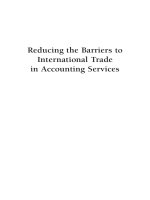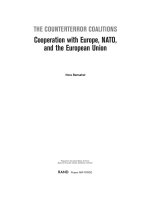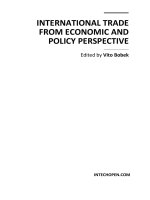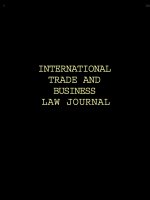Business Environment 9_ international trade, european union policies, economic monetary union
Bạn đang xem bản rút gọn của tài liệu. Xem và tải ngay bản đầy đủ của tài liệu tại đây (193.74 KB, 23 trang )
LECTURE for BE ASSIGNMENT 2
TASK 4
1
TASK 4A
Sources:
1.BPP Business Environment Coursebook (pages
278-289)
International Trade
Define what is international trade.
International trade is exchange of capital,
goods, and services across international
borders or territories. It refers to exports of
goods and services by a firm to a foreign-based
buyer (importer). In most countries, it
represents a significant share of gross domestic
product (GDP). While international trade has
been present throughout much of history, its
economic, social, and political importance has
been on the rise in recent centuries.
3
Importance of
International Trade
Discuss the importance of international trade.
Overseas markets represent new market segments
Saturation of its domestic market can force an organisation to seek
overseas markets
Organisation may wish to reduce its dependence upon one geographical
market
The nature of firm’s product may require an organisation to become
active in an overseas market
Commercial buyers of products operating in a number of overseas
countries may require their suppliers to be able to cater for their needs
across national boundaries
The removal of many restrictions on international trade
Increasing household disposable incomes results in greater consumption
of many categories of luxuries, such as overseas travel, which can only
be provided by overseas suppliers.
Cultural convergence that has resulted from improved communications
4
(more on pages 278-279; internet)
Economic Integration
Discuss the context of economic integration and its influences on
global market as well as local markets (VN and the rest of the
world)
Economic integration refers to trade unification between
different states by the partial or full abolishing of customs tariffs
on trade taking place within the borders of each state. This is
meant in turn to lead to lower prices for distributors and
consumers (as no customs duties are paid within the integrated
area) and the goal is to increase trade. The trade stimulation
effects intended by means of economic integration are part of the
contemporary economic Theory of the Second Best: where, in
theory, the best option is free trade, with free competition and no
trade barriers whatsoever. Free trade is treated as an idealistic
option, and although realized within certain developed states,
economic integration has been thought of as the "second best"
option for global trade where barriers to full free trade exist.
Do more internet research...
5
Influences of Economic
Integration
Discuss the influences of economic integration
on:
1. Global markets (rest of the world)
2. Local markets (VN)
3. Giay Viet Joint Stock Company
Do internet research...
6
TASK 4B
Sources: BPP Business Environment Coursebook
a. Monetary policy-EMS (page 300)
b. Common agriculture policy (page 300)
c. Social policy (page 307)
d. Regional policy (page 309)
CHOOSE only two (2) policies.
1.Define the policy.
2.Discuss the importance.
3.Discuss the impact on Giay Viet.
a. Monetary system (EMS)
European Monetary system was set up in 1979.
Its purpose is “ to establish greater monetary
stability in the European Union. The exchange
rates between currencies can fluctuate
considerably.” ( BBP Professional education,
2004)
In Europe, EMS is playing a very important role
to recognize change in relative prices, avoid
inflation risk premium, reduce the distortionary
impact of tax and social security systems and
maintain social cohesion and stability.
a. Monetary system (EMS)
European
Monetary System (EMS) was an arrangement
established in 1979 under the Jenkins European Commission
where most nations of the European Economic Community (EEC)
linked their currencies to prevent large fluctuations relative to one
another.
After the collapse of the Bretton Woods system in 1971, most of
the EEC countries agreed in 1972 to maintain stable exchange
rates by preventing exchange fluctuations of more than 2.25%
(the European "currency snake"). In March 1979, this system was
replaced by the European Monetary System, and the European
Currency Unit (ECU) was defined.
The basic elements of the arrangement were:
The ECU: A basket of currencies, preventing movements above
2.25% (6% for Italy) around parity in bilateral exchange rates with
other member countries.
An Exchange Rate Mechanism (ERM)
An extension of European credit facilities.
The European Monetary Cooperation Fund: created in October
1972 and allocates ECUs to members' central banks in exchange
for gold and US dollar deposits.
b. Common Agricultural Policy
(CAP)
The Common Agricultural Policy (CAP) is a system of European Union
agricultural subsidies and programmes. It represents 48% of the EU's
budget, €49.8 billion in 2006 (up from €48.5 billion in 2005).
The CAP combines a direct subsidy payment for crops and land which may
be cultivated with price support mechanisms, including guaranteed
minimum prices, import tariffs and quotas on certain goods from outside
the EU. Reforms of the system are currently underway reducing import
controls and transferring subsidy to land stewardship rather than specific
crop production (phased from 2004 to 2012). Detailed implementation of
the scheme varies in different member countries of the EU.
Until 1992 the agriculture expenditure of the European Union represented
nearly 49% of the EU's budget. By 2013, the share of traditional CAP
spending is projected to decrease significantly to 32%, following a
decrease in real terms in the current financing period. In contrast, the
amounts for the EU's Regional Policy represented 17% of the EU budget in
1988. They will more than double to reach almost 36% in 2013.
The aim of the common agricultural policy (CAP) is to provide farmers with
a reasonable standard of living, consumers with quality food at fair prices
and to preserve rural heritage. However, there has been considerable
criticism of CAP.
c. Social Policy
Promoted
close co-operation between
member states, particularly in matters
relating to training, employment, working
conditions, social security & collective
bargaining, equal pay principle and make
provision for the harmonisation of social
security
measures
to
accommodate
migrant workers.
See more on page 307
d. Regional Policy
The Regional policy of the European Union (EU) is a
policy with the stated aim of improving the economic wellbeing of certain regions in the EU. Around one third of the
EU's budget is devoted to this policy, the aim of which has
been stated to be to remove the disparities in wealth across
the EU, restructure declining industrial areas and to diversify
rural areas which have declining agriculture.
The most significant enlargement of the European Union
took place in May 2004 with ten new member states, mostly
from eastern or central Europe, followed by accession of
Bulgaria and Romania in January 2007. Most of these states
are poorer than the existing members and the impact of this
means that the EU's average GDP per capita has been
reduced leading to some regions in the earlier EU-15 no
longer qualifying for extra financial help. On the other hand,
most regions in the new member states do qualify.
Regions needing support with the regional policy are given
either objective one or objective two status. Objective three
regions cover all regions of the EU which do not have
objective one or two status.
TASK 4C
Sources:
BPP Business Environment Coursebook (pages 303-306)
1.What is EMU?
2.The advantages of an EMU member countries
3.Pros and cons of joining EMU
4.Express your own idea: Should UK enter into EMU?
Explain.
What is EMU?
A monetary union is an arrangement where several countries
have agreed to share a single currency amongst themselves.
The European Economic and Monetary Union (EMU) consists
of three stages coordinating economic policy, achieving
economic convergence (that is, their economic cycles are
broadly in step) and culminating with the adoption of the euro,
the EU's single currency. All member states of the European
Union are expected to participate in the EMU.
The Copenhagen criteria is the current set of conditions of entry
for states wanting to join the EU. It contains the requirements
that need to be fulfilled and the time framework within which
this must be done in order for a country to join the monetary
union. An important element of this is the European Exchange
Rate Mechanism ("ERM II"), in which candidate currencies
demonstrate economic convergence by maintaining limited
deviation from their target rate against the euro.
14
What is EMU?
All member states, except Denmark and the
United Kingdom, have committed themselves by
treaty to join EMU. Sixteen member states of the
European Union have entered the third stage and
have adopted the euro as their currency.
Denmark, Estonia, Latvia, and Lithuania are the
current participants in the exchange rate
mechanism. Of the pre-2004 members, the
United Kingdom and Sweden have not joined
ERM II and Denmark remains in ERM without
proceeding to the third stage. The five remaining
(post-2004) states have yet to achieve sufficient
convergence to participate. These eleven EU
members continue to use their own currencies.
15
What is EMU?
Stage One: 1 July 1990 to 31 December 1993
On 1 July 1990, exchange controls were abolished, thus
capital movements were completely liberalised in the
European Economic Community.
The Treaty of Maastricht in 1992 establishes the
completion of the EMU as a formal objective and sets a
number of economic convergence criteria, concerning
the inflation rate, public finances, interest rates and
exchange rate stability.
The treaty enters into force on the 1 November 1993.
16
What is EMU?
Stage Two: 1 January 1994 to 31 December 1998
The European Monetary Institute is established as the forerunner of
the European Central Bank, with the task of strengthening monetary
cooperation between the member states and their national banks, as
well as supervising ECU banknotes.
On 16 December 1995, details such as the name of the new currency
(the euro) as well as the duration of the transition periods are decided.
On 16-17 June 1997, the European Council decides at Amsterdam to
adopt the Stability and Growth Pact, designed to ensure budgetary
discipline after creation of the euro, and a new exchange rate
mechanism (ERM II) is set up to provide stability above the euro and
the national currencies of countries that haven't yet entered the
eurozone.
On 3 May 1998, at the European Council in Brussels, the 11 initial
countries that will participate in the third stage from 1 January 1999
are selected.
On 1 June 1998, the European Central Bank (ECB) is created, and in 31
December 1998, the conversion rates between the 11 participating
national currencies and the euro are established.
17
What is EMU?
Stage Three: 1 January 1999 and continuing
From the start of 1999, the euro is now a real currency,
and a single monetary policy is introduced under the
authority of the ECB. A three-year transition period
begins before the introduction of actual euro notes and
coins, but legally the national currencies have already
ceased to exist.
On 1 January 2001, Greece joins the third stage of the
EMU.
The euro notes and coins are introduced in January 2002.
On 1 January 2007, Slovenia joins the third stage of the
EMU.
On 1 January 2008, Cyprus and Malta join the third stage
of the EMU.
On 1 January 2009, Slovakia joins the third stage of the
EMU.
18
The advantages of an EMU
member countries
If everything goes to plan, by 2002, participating member states of
the European Union will have ditched their national currency in favour
of the euro, a single European currency. The advantages and
disadvantages of joining the European Monetary Union (Emu) will vary
from country to country, and are difficult to predict. Within the EU,
each member state has its own financial system; therefore the
introduction of the Euro will make a different impact on each country's
economy. But economists say that there are a number of advantages
in signing up to the euro:
Currency stability
A single currency should end currency instability in the participating
countries (by irrevocably fixing exchange rates) and reduce it outside
them.
Because the euro would have the enhanced credibility of being used in
a large currency zone, it would be more stable against speculation
than individual currencies are now.
An end to internal currency instability and a reduction of external
19
currency instability would enable exporters to project future markets
with greater certainty. This could unleash great potential for growth.
The advantages of an EMU
member countries
Cheaper mortgages, lower interest rates
A single currency should also result in lower interest rates as
all member countries if the new European Central bank takes
on the monetary credibility of Germany's Bundesbank.
The stability pact (the main points of which were agreed at the
Dublin summit of European heads of state or government in
December 1996) will force EU countries into a system of fiscal
responsibility which will enhance the euro's international
credibility.
This should lead to more investment, more jobs, lower interest
rates - and for home owners to lower mortgages.
20
The advantages of an EMU
member countries
Tourism
Consumers would not have to change money when travelling within the
euro zone, and would encounter less red tape when transferring large sums
of money across borders.
Travellers will no longer be forced to change money and pay banks the
commission charges.
A consumer might wish to make one large purchase or transaction across a
European border such as buying a holiday home or a piece of furniture. A
single currency would help such transactions pass smoothly.
Business benefits
Likewise, businesses would no longer have to pay hedging costs which they
do today in order to insure themselves against the threat of currency
fluctuations.
Businesses, involved in commercial transactions in different member states,
would no longer have to face the costs of accounting in different currencies.
Surprisingly, small firms stand the most to gain. Experts estimate that
21
currently the currency cost of exports is ten times higher for small
companies than for multi-nationals, who can offset sales against purchases
and command the best rates.
Pros and Cons of Joining EMU
Advantages
Disadvantages
1. Economic policy stability
1.Loss of national control over economic
2. Facilitation of trade
policy
3. Lower interest rates
2. The need to compensate 3. Confusion in
4. Preservation of the City’s position:
the transition to EMU:
4. Lower confidence arising from loss of
national pride
Express your own idea:
Should UK enter into EMU?
Explain.









